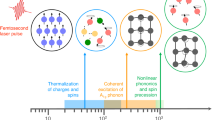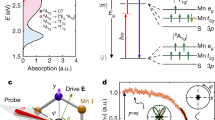Abstract
In magnetoelectric and multiferroic materials, the magnetic degree of freedom can be controlled by electric field, and vice versa. A significant amount of research has been devoted to exploiting this effect for magnetoelectric data storage and manipulation devices driven by d.c. electric fields1,2,3,4. Aiming at ever-faster schemes of magnetoelectric manipulation, a promising alternative approach offers similar control on a femtosecond timescale, relying on laser pulses4,5,6 to control both the charge7,8 and the magnetic9,10 order of solids. Here we photo-induce magnetoelectricity and multiferroicity in CuB2O4 on a sub-picosecond timescale. This process is triggered by the resonant optical generation of the highest-energy magnetic excitations—magnons with wavevectors near the edges of the Brillouin zone. The most striking consequence of the photo-excitation is that the absorption of light becomes non-reciprocal, which means that the material exhibits a different transparency for two opposite directions of propagation of light. The photo-induced magnetoelectricity does not show any decay on the picosecond timescale. Our findings uncover a path for ultrafast manipulations of the intrinsic coupling between charges and spins in multiferroics4, which may reveal unexplored magnetic configurations and unravel new functionalities in terms of femtosecond optical control of magnetism.
This is a preview of subscription content, access via your institution
Access options
Access Nature and 54 other Nature Portfolio journals
Get Nature+, our best-value online-access subscription
$29.99 / 30 days
cancel any time
Subscribe to this journal
Receive 12 print issues and online access
$209.00 per year
only $17.42 per issue
Buy this article
- Purchase on Springer Link
- Instant access to full article PDF
Prices may be subject to local taxes which are calculated during checkout





Similar content being viewed by others
References
Fiebig, M. Revival of the magnetoelectric effect. J. Phys. D. Appl. Phys. 38, R123–R152 (2005).
Kosub, T. et al. Purely antiferromagnetic magnetoelectric random access memory. Nat. Commun. 8, 13985–13992 (2017).
He, X. et al. Robust isothermal electric control of exchange bias at room temperature. Nat. Mater. 9, 579–585 (2010).
Fiebig, M., Lottermoser, T., Meier, D. & Trassin, M. The evolution of multiferroics. Nat. Rev. Mater. 16046–16060 (2016).
Sheu, Y. M. et al. Using ultrashort optical pulses to couple ferroelectric and ferromagnetic order in an oxide heterostructure. Nat. Commun. 5, 5832 (2014).
Johnson, S. L. et al. Femtosecond dynamics of the collinear-to-spiral antiferromagnetic phase transition in CuO. Phys. Rev. Lett. 108, 037203–037208 (2012).
Rini, M. et al. Control of the electronic phase of a manganite by mode-selective vibrational excitation. Nature 449, 72–74 (2007).
Fausti, D. et al. Light-induced superconductivity in a stripe-ordered cuprate. Science 331, 189–191 (2011).
Stupakiewicz, A., Szerenos, K., Afanasiev, D., Kirilyuk, A. & Kimel, A. V. Ultrafast nonthermal photo-magnetic recording in a transparent medium. Nature 542, 71–74 (2017).
Bossini, D., Belotelov, V. I., Zvezdin, A. K., Kalish, A. N. & Kimel, A. V. Magnetoplasmonics and femtosecond optomagnetism at the nanoscale. ACS Photon 3, 1385–1400 (2016).
Martinez-Ripoll, M., Martnez-Carrera, S. & Garca-Blanco, S. The crystal structure of copper metaborate, CuB2O4. Acta Crystallogr. B 27, 677–681 (1971).
Petrakovskii, G. et al. Weak ferromagnetism in CuB2O4 copper metaborate. J. Magn. Magn. Mater. 205, 105–109 (1999).
Martynov, S., Petrakovskii, G., Boehm, M., Roessli, B. & Kulda, J. Spin-wave spectrum of copper metaborate in the incommensurate phase. J. Magn. Magn. Mater. 299, 75–81 (2006).
Khanh, N. D. et al. Magnetic control of electric polarization in the noncentrosymmetric compound (Cu,Ni)B2O4. Phys. Rev. B 87, 184416–184421 (2013).
Saito, M., Arima, T., Ishikawa, K. & Taniguchi, K. Magnetic control of crystal chirality and the existence of a large magneto-optical dichroism effect in CuB2O4. Phys. Rev. Lett. 101, 117402 (2008).
Toyoda, S. et al. One-way transparency of light in multiferroic CuB2O4. Phys. Rev. Lett. 115, 267207 (2015).
Toyoda, S., Abe, N. & Arima, T. Gigantic directional asymmetry of luminescence in multiferroic CuB2O4. Phys. Rev. B 93, 201109 (2016).
Peyghambarian, N., Koch, S. W. & Mysyrowicz, A. Introduction to Semiconductor Optics. (Prentice Hall, Englewood Cliffs, NJ/London, 1993).
TanabeY.. & Aoyagi, A. K. Excitons in Magnetic Insulators. (North-Holland, 1982).
Macfarlane, R. M. & Allen, J. W. Exciton bands in antiferromagnetic Cr2O3. Phys. Rev. B 4, 3054–3067 (1971).
Moriya, T., Tanabe, Y. & Sugano, S. Magnon-induced electric dipole transition moment. Phys. Rev. Lett. 15, 1023–1025 (1965).
Fiebig, M., Sänger, I. & Pisarev, R. V. Magnetic phase diagram of CuB2O4. J. Appl. Phys. 93, 6960–6963 (2003).
LandauL. D.. & Lifshitz, E. Electrodynamics of Continuous Media. 2nd edn, (Elsevier, 1984).
Kimel, A. V., Pisarev, R. V., Hohlfeld, J. & Rasing, T. ultrafast quenching of the antiferromagnetic order in FeBO3: direct optical probing of the phonon–magnon coupling. Phys. Rev. Lett. 89, 287401–287405 (2002).
Bossini, D., Kalashnikova, A. M., Pisarev, R. V., Rasing, T. & Kimel, A. V. Controlling coherent and incoherent spin dynamics by steering the photo-induced energy flow. Phys. Rev. B 89, 060405 (2014).
Afanasiev, D. et al. Control of the ultrafast photoinduced magnetization across the Morin transition in DyFeO3. Phys. Rev. Lett. 116, 097401 (2016).
Bossini, D. et al. Macrospin dynamics in antiferromagnets triggered by sub-20 femtosecond injection of nanomagnons. Nat. Commun. 7, 10645–10653 (2016).
Bossini, D. & Rasing, T. Femtosecond optomagnetism in dielectric antiferromagnets. Phys. Scr. 92, 024002 (2017).
Ivanov, V. G. et al. Phonon and magnon Raman scattering in CuB2O4. Phys. Rev. B 88, 094301 (2013).
Hashimoto, Y. et al. All-optical observation and reconstruction of spin wave dispersion. Nat. Commun. 8, 15859–15865 (2017).
Pisarev, R. V., Kalashnikova, A. M., Schöps, O. & Bezmaternykh, L. N. Electronic transitions and genuine crystal-field parameters in copper metaborate CuB2O4. Phys. Rev. B 84, 075160 (2011).
Brito Cruz, C. H., Gordon, J. P., Becker, P. C., Fork, R. L. & Shank, C. V. Dynamics of spectral hole burning. IEEE J. Quantum Electron. 24, 261–269 (1988).
Acknowledgements
We thank J. Omachi for the time-resolved photoluminescence measurements and N. Nemoto, Y. Arashida and H. Sakurai for technical support. This work was supported by JSPS KAKENHI grant no. 26247049 and the Photon Frontier Network Program funded by the Ministry of Education, Culture, Sports, Science, and Technology (MEXT), Japan. D.B was supported by the Japanese Society for Promotion of Science (JSPS) ‘Postdoctoral Fellowship for Overseas Researcher’ no. P16326. S.T was also supported by JSPS through the Program for Leading Graduate Schools (MERIT) and a Grant-in-Aid for JSPS Fellows (14J06840).
Author information
Authors and Affiliations
Contributions
D.B. conceived the project with contributions from K.K., T.A. and M.K-G. The sample was grown and characterized by S.T. D.B. performed the time-resolved experiments and analysed the data. All the authors took part in regular discussions and contributed to the writing of the manuscript.
Corresponding author
Ethics declarations
Competing interests
The authors declare no competing financial interests.
Additional information
Publisher’s note: Springer Nature remains neutral with regard to jurisdictional claims in published maps and institutional affiliations.
Supplementary information
Supplementary Notes
Supplementary Notes 1–3, Supplementary References.
Rights and permissions
About this article
Cite this article
Bossini, D., Konishi, K., Toyoda, S. et al. Femtosecond activation of magnetoelectricity. Nature Phys 14, 370–374 (2018). https://doi.org/10.1038/s41567-017-0036-1
Received:
Accepted:
Published:
Issue Date:
DOI: https://doi.org/10.1038/s41567-017-0036-1
This article is cited by
-
A review on current status and mechanisms of room-temperature magnetoelectric coupling in multiferroics for device applications
Journal of Materials Science (2022)
-
Subpicosecond metamagnetic phase transition in FeRh driven by non-equilibrium electron dynamics
Nature Communications (2021)
-
Vibrational coherent control of localized d–d electronic excitation
Nature Physics (2021)



